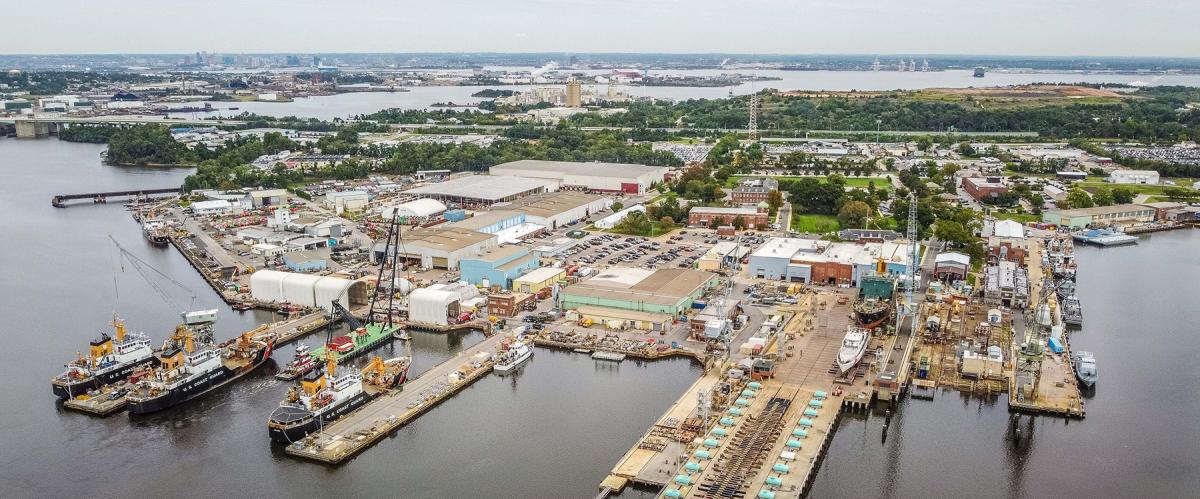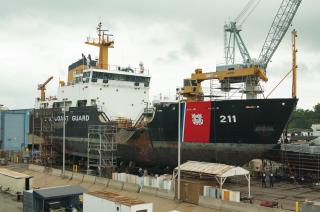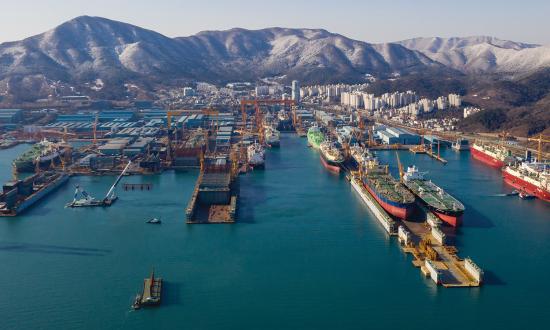As the Coast Guard continues to grow its blue-water assets in both tonnage and quantity, it needs a major Coast Guard–owned and –operated shipyard on the West Coast. The existing Coast Guard maintenance infrastructure relies on regional industrial production facilities, maintenance assist teams, and the Coast Guard Yard in Baltimore, Maryland, for all organic depot-level work. These facilities already operate at 100-percent capacity. Excess depot work, in addition to any work that falls outside organic Coast Guard capabilities, is put out for bid to commercial yards or industrial groups.
While the current arrangement has worked reasonably well, with commercial yards providing work at competitive prices, reliability and scheduling issues still occur. A West Coast yard would increase operational availability and better control maintenance availability schedules while ensuring critical cutter maintenance would not become a casualty of a shrinking shipyard industrial base.
Reliability Improvement
Historical data obtained from the Federal Procurement Data System on the medium endurance cutter fleet show that the Coast Guard Yard in Baltimore has consistently finished work with statistically significant fewer project extensions. I analyzed 67 medium endurance cutter drydock availabilities with publicly available data on drydock contracts completed by three commercial shipyards and the Coast Guard Yard from 2009 through 2022. The Coast Guard Yard consistently completed availabilities closer to planned end dates, ensuring the same or similar depot maintenance was completed in shorter time periods. Average schedule overrun at the Coast Guard Yard was approximately 6.5 days for an average planned period of 64 days, slightly better than the best commercial yard at 7.1 days for a shorter average project duration of 47 days.
The other two commercial yards analyzed both completed projects roughly 19 days late for an average planned project duration of 70 days. With far more projects completed than the best commercial yard, these two yards offer a more accurate picture of commercial yard completion rates.
This data strongly suggest that the Coast Guard Yard is more responsive to the Coast Guard’s schedule demands. Commercial yards are profit oriented, and contracts that pay better will be prioritized over low-profit-margin government work. At the Coast Guard Yard, the service is the prime customer, only competing internally to allocate scarce maintenance resources. This increase in schedule reliability is the direct result of a shipyard sensitive to Coast Guard operational schedules, less insulated from operational commanders’ concerns, and without the pressure of higher-paying commercial competition. While historical data support the conclusion that a Coast Guard–owned and –operated yard would improve schedule times, a 2019 Congressional Budget Office report found that the federal naval shipyards were consistently more expensive than their commercial peers in completing routine attack submarine maintenance.1
While the reasons for this greater cost at naval shipyards are not entirely clear, it suggests similar additional costs exist at the Coast Guard Yard, probably because government-run yards do not seek to maximize profit and sometimes use less efficient but more reliable methods. Thus, the increase in schedule reliability is not free, as commercial yards prioritize cost-cutting measures and efficiency—albeit sometimes to the detriment of safety or schedule.
Yet, increased reliability and timeliness is worth the additional cost. Presently, the Coast Guard’s large cutter fleet is operating at an unsustainable rate, conducting counternarcotic missions in the eastern Pacific, freedom-of-navigation and Department of Defense support patrols in the western Pacific, migrant interdiction and humanitarian support operations in the Caribbean, fisheries enforcement in the North Atlantic and Bering Sea, scientific expeditions and support in the Arctic and Antarctic Oceans, and force protection in the Middle East area of operations.2
Current preventive maintenance standards require the Coast Guard to place its medium endurance and long-range cutters in drydock every four years, with drydock duration ranging from two to three months.3 This translates to roughly 5 percent of the fleet being high and dry on blocks at any given moment. Using the commercial yard average overrun, this 5 percent number jumps to 6.3 percent (assuming 2.5-month drydock average and commercial slippage of 18 percent).4 While an operational availability decrease of slightly more than 1 percent seems trivial at first glance, it is not. In the medium endurance cutter fleet alone, there are roughly six drydock availabilities each year. If each ran over the planned length by the commercial yard average, the operational commander would lose approximately 110 underway days a year. That is almost two 60-day patrols annually swallowed by commercial yard schedule slippage. Over the life of a 210-foot medium endurance cutter (which has been stretched to 60 years), that comes out to roughly 300 lost operational days. While federal shipyards have been shown to be more expensive, their additional reliability and optimization of cutter availability are worth the cost.
A Declining Base
Much has been written about the gradual decline in the U.S. defense industrial base and shipbuilding/repair capacity. A 2018 interagency report identifies the major decline in shipyard capacity, consolidation of ship manufacturing companies, and loss of Navy underway days because of maintenance constraints.5 While actions have since been taken to address these issues, significant work remains to reverse the multidecade decline.
While continuing to work with commercial partners, the Coast Guard should hedge against inadequate ship repair capacity by establishing its own skilled workforce on the West Coast. By following the example of the Coast Guard Yard in Baltimore, a shipyard that focuses on servicing the growing Pacific area fleet would ensure Coast Guard cutters are receiving timely and required maintenance without competing for increasingly scarce commercial ship-repair berths. While the initial cost to establish a shipyard would be substantial, lost operational days because of overreliance on the declining commercial sector may result in an inability to complete required maintenance and the material degradation of Coast Guard vessels.
The Coast Guard cannot hope for commercial yard expansion. As the Coast Guard fleet grows and ship repair capacity shrinks, it follows from simple supply and demand that costs will rise, and fewer ships will receive repair work. Since ship repair and maintenance require substantial initial capital expenditure, significant and sustained demand is required for commercial yards to invest in expansion.6 This delays additional commercial growth and argues for federal investment in a second Coast Guard yard.
This same logic was recently used to convince Congress to approve an expansion of the current Coast Guard Yard in the fiscal year 2023 National Defense Authorization Act.7 This will include $636 million for repairs to World War II–era equipment and expansions and capacity upgrades, enabling the yard to accommodate the highly anticipated offshore patrol cutters. This is a blueprint for construction of a West Coast yard to service the Pacific area fleet.
Ship repair and fleet sustainment is highly complex and industrial. To suggest that simply adding an additional shipyard in a new geographic region will solve future maintenance issues is naive. However, given that historical data show the Coast Guard Yard has consistently provided more timely and reliable services to Atlantic Area medium endurance cutters, it makes sense to conduct a serious analysis of the cost and benefits of a West Coast yard for a growing Pacific area fleet.
1. Congressional Budget Office, “Costs of Submarine Maintenance at Public and Private Shipyards,” April 2019, www.cbo.gov/system/files/2019-04/55032 Submarine_Maintenance_Costs.pdf.
2. Michaela Ross, “Coast Guard Warns Mission ‘Unsustainable’ as Resources Lag,” Bloomberg Government, 20 February 2020.
3. U.S. Department of Homeland Security, U.S. Coast Guard, U.S. Coast Guard Instruction M9000.6G: Naval Engineering Manual (Washington, DC: Commandant, U.S. Coast Guard, 21 October 2004).
4. While the average of the commercial project over-run is substantially higher than 18 percent (a project-day weighted average comes out to 29 percent), by removing the four most overrun projects (which drastically decrease the commercial yards’ collective ability to finish near deadlines), a more competitive 18 percent average is calculated. This was used because it is ostensibly more realistic, as the Coast Guard Yard does not have any project overruns that are more than double the original period.
5. U.S. Department of Defense, Report to President Donald J. Trump by the Interagency Task Force in Fulfillment of Executive Order 13806: Assessing and Strengthening the U.S. Manufacturing and Defense Industrial Base and Supply Chain Resiliency of the United States (Washington, DC: Department of Defense), September 2018.
6. Justin Katz, “Citing Industry Capacity, Navy’s Gilday Throws Cold Water on Three Destroyers Per Year,” Breaking Defense, 14 September 2022.
7. Craig Hooper, “Senators Demand $632 Million for Coast Guard Yard,” Forbes, 29 June 2022.






